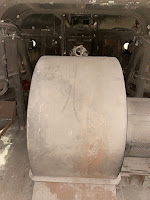Courtesy of Bill Wulfert, we can take a virtual tour of the interior of the GG1 which he is working on!
All images are copyright by the photographer and may not be reproduced without permission.
By popular request, here are some interior photos of Pennsylvania Railroad GG1 #4927 at IRM.
1. Forward view of the engineer's cab. Note the number 4939 stenciled on the curved arch. Our engine was renumbered as 4939, as 4927 conflicted with other Amtrak equipment. Controller (black) on the left. Brake stand on the right.
2. View of various gauges just to
the left of the engineer.
3. Straight forward view of the controls. Note the engineer's seat that was destroyed by animals that got into the locomotive.
4. Engineer's forward view
5. Air gauges and speedometer.
6. Cab Signal Display
7.Hand painted warning lights.
8. Three Ammeters
9. Fireman's view with repaired cab
signal display, which were all broken upon delivery.
10. DANGER 500 VOLTS
11. Engineer's seat and side window
12. Controller Type XM 288B. The one
in the other cab is missing the controller top. Anyone have a spare lying
around?
13. View of the engineer's position
from the fireman's seat. DANGER 1400 VOLTS
14. DANGER 500 / 1000 VOLTS
15. Toilet in the number 1 end nose
area. The metal plate to the right can be lowered over the toilet. Imagine
using that while the train is moving at 100 MPH.
17. The Steam Generator, looking through the access door.
18. The Transformer Room, with the transformer and tap changer (control group) removed. Also a dead water cooler.
19. Blower - One in each end.
20. Looking over the blower to the twin sealed beam headlights.
21. The articulated truck connection. Female on the left, male on the right.
22. Opening to the north end of the engine. The door frame is 17" wide.
23. The hallway to the north end has 18" of clearance side to side. Some air and electrical equipment on each side.
24. Hallway along the east side of the engine. Sand box on the left, and the steam generator is in the compartment to the right.
25. A peek at the steam generator.
Too close to get a full shot.

























Very interesting photos, Bill. I wonder how many of our active current museum members (myself included) could squeeze through those passageways. Engine crews on the Pennsy must have been weight-conscious.
ReplyDeleteDan Buck
It always struck me how confining those cabs are and how little room you have to move around. Claustrophobes need not apply. And then what a constricted view you have of where you're going. Our electric cars are generally much more open and provide a much better view of the surroundings.
ReplyDeleteMoving forward forty years to 1982, one might presume that our AEM-7 could not be nearly so cramped. For the cabs, they'd be right. The 945's cabs are as roomy as a contemporary diesel locomotive, with good visibility and a decent layout. But opening up the doors into the machinery room reveals corridors that are both as narrow and vertically short as the GG-1. The toilet is right next to the air compressor and one of the traction motor blowers, and had to be a bit deafening to use. It's not divided into rooms like the GG-1 is, but the equipment in the center is floor-to-ceiling the whole length and width and it feels very claustrophobic.
ReplyDeleteIf Randy's interested in posting some pictures, I'll see if I can take some this weekend.
R. W. Schauer
It's a deal, Richard. Thanks!
ReplyDeleteThe P5a's were box cabs with the windows and cabs at the ends. After a grade crossing accident, the last ones were built with cabs in the middle. The GG-1's continued this format. The view from the GG-1 is similar to what you would see when operating a steam engine. Most GG-1 engineers were probably used to the view.
ReplyDeleteAlso a correction. Somehow description 21 is backwards! "The articulated truck connection. Female on the LEFT, male on the RIGHT!
Bill is, of course, correct about the P5a's. The only preserved one at St. Louis has the original boxcab design. But survivability was more important than field of vision. It's interesting that the AEM-7 returns to an end-cab design; I believe nowadays there are essentially no grade crossings on the Corridor. Or is that not correct?
ReplyDeleteThe last grade crossings on the NY-Washing portion of the NE Corridor were in Maryland and closed in the late 1980's. Since then it has been grade separated New York-Washington. I think there may be a couple of grade crossings between New Haven and Boston left though. - Robert, IRM member / grew up on the Corridor in NJ
ReplyDeleteI've never been inside a real GG-1, but a friend of mine got to cab one of Strasburg's GG-1s back in 2016. I couldn't believe just how cramped it was despite how big the GG-1 is as a locomotive. It's funny you posted this, because I'm looking at getting a Lionel MPC GG-1 in the near future.
ReplyDelete-Matt